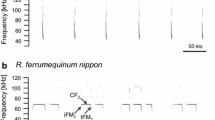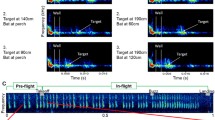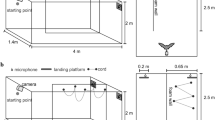Abstract
The approach phase of landing vespertilionid bats ends with a group of calls, which either consists of buzz I alone or buzz I and buzz II. To understand the possible role of buzz II, we trained Myotis myotis to land on a vertical grid, and compared the flight and echolocation behavior during approach in trials with and without buzz II. During the approach, we did not find any differences in the echolocation behavior until the end of buzz I which indicated whether buzz II was emitted or not. However, bats flying from the periphery of the flight channel, such that they had to make a small turn at the very last moment, finished the sequence with a buzz II. Bats flying on a rather stereotyped trajectory near the center of the flight channel without last instant corrections emitted buzz I alone. Our results indicate that buzz II occurred only on trajectories that implied a higher risk to fail at landing. The information delivered by buzz II reaches the bat too late to be used for landing. Therefore, we hypothesize that buzz II may help the bats to evaluate unsuccessful attempts and to eventually react adequately.





Similar content being viewed by others
Abbreviations
- SPL:
-
Sound pressure level
References
Arlettaz R, Jones G, Racey PA (2001) Effect of acoustic clutter on prey detection by bats. Nature 414:742–745
Barclay RMR (1985) Long versus short-range foraging strategies of hoary (Lasiurus cinereus) and silver-haired (Lasionycteris noctivagans) bats and consequences for prey selection. Can J Zool 63:2507–2515
Barclay RMR (1986) The echolocation calls of hoary (Lasiurus cinereus) and silver-haired (Lasionycteris noctivagans) bats as adaptations for long versus short-range foraging strategies and the consequences for prey selection. Can J Zool 64:2700–2705
Boonman A, Jones G (2002) Intensity control during target approach in echolocating bats; stereotypical sensori-motor behaviour in Daubenton’s bats, Myotis daubentonii. J Exp Biol 205:2865–2874
Britton ARC, Jones G, Rayner JMV, Boonman AM, Verboom B (1997) Flight performance, echolocation and foraging behavior in pond bats, Myotis dasycneme (Chiroptera: Vespertilionidae). J Zool Lond 241:503–522
Denzinger A, Siemers BM, Schaub A, Schnitzler H-U (2001) Echolocation by the barbastelle bat, Barbastella barbastellus. J Comp Physiol A 187:521–528
Dusterhoft F, Hausler U, Jürgens U (2000) On the search for the vocal pattern generator. A single-unit recording study. Neuroreport 11(9):2031–2034
Faure PA, Barclay RMR (1994) Substrate-gleaning versus aerial-hawking: plasticity in the foraging and echolocation behaviour of the long-eared bat Myotis evotis. J Comp Physiol A 174:651–660
Faure PA, Fullard JH, Dawson JW (1993) The gleaning attacks of the northern long-eared bat, Myotis septentrionalis, are relatively inaudible to moths. J Exp Biol 178:173–189
Fenzl T, Schuller G (2002) Periaqueductal gray and the region of the paralemniscal area have different functions in the control of vocalization in the neotropical bat, Phyllostomus discolor. Eur J NeuroSci 16:1974–1986
Fenzl T, Schuller G (2005) Echolocation calls and communication calls are controlled differentially in the brainstem of the bat Phyllostomus discolor. BMC Biol 3:17–28
Griffin DR, Webster FA, Michael CR (1960) The echolocation of flying insects by bats. Anim Behav 8:141–154
Habersetzer J, Vogler B (1983) Discrimination of surface-structured targets by the echolocating bat Myotis myotis during flight. J Comp Physiol A 152:275–282
Hage SR, Jürgens U (2006) On the role of the pontine brainstem in vocal pattern generation: a telemetric single-unit recording study in the squirrel monkey. J Neurosci 26(26):7105–7115
Hartley DJ (1992) Stabilization of perceived echo amplitudes in echolocating bats. I. Echo detection and automatic gain control in the big brown bat, Eptesicus fuscus, and the fishing bat, Noctilio leporinus. J Acoust Soc Am 91(2):1120–1132
Jones G, Rayner JMV (1988) Flight performance, foraging tactics and echolocation in free-living Daubenton’s bats Myotis daubentoni (Chiroptera: Vespertilionidae). J Zool Lond 215:113–132
Jones G, Rayner JMV (1991) Flight performance, foraging tactics and echolocation in trawling insectivorous bat, Myotis adversus (Chiroptera: Vespertilionidae). J Zool Lond 225:393–412
Jürgens U (2000) Localization of a pontine vocalization-controlling area. J Acoust Soc Am 108(4):1393–1396
Kalko EKV (1995) Insect pursuit, prey capture and echolocation in pipistrelle bats (Microchiroptera). Anim Behav 50:861–880
Kalko EKV, Condon MA (1998) Echolocation, olfaction and fruit display: how bats find fruit of flagellichorous cucurbits. Funct Ecol 12:364–372
Kalko EKV, Schnitzler H-U (1989) The echolocation and hunting behavior of Daubenton’s bat, Myotis daubentoni. Behav Ecol Sociobiol 24:225–238
Lee DN, Simmons JA, Saillant PA, Bouffard F (1995) Steering by echolocation: a paradigm of ecological acoustics. J Comp Physiol A 176:347–354
Masters WM, Moffat AJM, Simmons JA (1985) Sonar tracking of horizontally moving targets by the big brown bat, Eptesicus fuscus. Science 228:1331–1333
Melcón ML, Denzinger A, Schnitzler H-U (2007) Aerial hawking and landing: approach behaviour in Natterer’s bats, Myotis nattereri (Kuhl 1818). J Exp Biol 210:4457–4464
Miller LA, Degn HJ (1981) The acoustic behavior of four species of vespertilionid bats studied in the field. J Comp Physiol 142:67–74
Neuweiler G (1989) Foraging ecology and audition in echolocating bats. Trends Ecol Evol 4:160–166
Nordmark J (1960) Perception of distance in animal echo-location. Nature 188:1009–1010
Russo D, Jones G, Arlettaz R (2007) Echolocation and passive listening by foraging mouse-eared bats Myotis myotis and M. blythii. J Exp Biol 210:166–176
Rydell J (1990) Behavioural variation in echolocation pulses of the Northern bat, Eptesicus nilssoni. Ethology 85:103–113
Schnitzler H-U, Kalko EKV (1998) How echolocating bats search and find food. In: Kunz TH, Racey PA (eds) Bat biology and conservation. Smithsonian Institution Press, Washington DC, pp 183–196
Schnitzler H-U, Kalko EKV (2001) Echolocation by insect-eating bats. Bioscience 5(7):557–569
Schnitzler H-U, Moss CF, Denzinger A (2003) From spatial orientation to food acquisition in echolocating bats. Trends Ecol Evol 18:386–394
Schuller G, Radtke-Schuller S (1990) Neural control of vocalization in bats: mapping of brainstem areas with electrical microstimulation eliciting species-specific echolocation calls in the rufous horseshoe bat. Exp Brain Res 79:192–206
Schumm A, Krull D, Neuweiler G (1991) Echolocation in the notch-eared bat, Myotis emarginatus. Behav Ecol Sociobiol 28:255–261
Siemers BM, Schnitzler H-U (2000) Natterer’s bat (Myotis nattereri Kuhl, 1818) hawks for prey close to vegetation using echolocation signals of very broad bandwidth. Behav Ecol Sociobiol 47:400–412
Surlykke A, Miller LA, Mohl B, Andersen BB, Christensen-Dalsgaard J, Jorgensen MB (1993) Echolocation in two very small bats from Thailand: Craseonycteris thonglongyai and Myotis siligorensis. Behav Ecol Sobiobiol 33:1–12
Thies W, Kalko EKV, Schnitzler H-U (1998) The roles of echolocation in two neotropical fruit-eating bats, Carollia perspicillata and C. castanea, feeding on Piper. Behav Ecol Sociobiol 42:397–409
Thurlow WR, Smith AM (1955) Pitch perception for certain periodic auditory stimuli. J Acoust Soc Am 27:132–137
Tian B, Schnitzler H-U (1997) Echolocation signals of the Greater Horseshoe bat (Rhinolophus ferrumequinum) in transfer flight and during landing. J Acoust Soc Am 101(4):2347–2364
von Helversen D, von Helversen O (1999) Acoustic guide in bat-pollinated flower. Nature 398:759–760
Webster FA (1967) Some acoustical differences between bats and men. In: Dufton R (ed) International conference on sensory devices for the blind. St. Dunstan’s, London, pp 63–87
Acknowledgments
We acknowledge Dr. P. Stilz for writing the program used for sound parameter analysis, Dr. P. Pilz for useful comments and Dr. S. A. Kim for revision of English. We also thank I. Körner for assisting with the reconstruction of the flight paths. This project was supported by SFB 550, and M.L.M. was supported by the German Academic Exchange Service. The experiments reported here adhere to the “Principles of animal care” (publication No. 86-23, revised 1985 of the NIH) and also comply with the current German animal protection law. Bats were held in the animal facilities at the University of Tübingen (approved by the Regierungspräsidium Tübingen).
Author information
Authors and Affiliations
Corresponding author
Rights and permissions
About this article
Cite this article
Melcón, M.L., Schnitzler, HU. & Denzinger, A. Variability of the approach phase of landing echolocating Greater Mouse-eared bats. J Comp Physiol A 195, 69–77 (2009). https://doi.org/10.1007/s00359-008-0383-6
Received:
Revised:
Accepted:
Published:
Issue Date:
DOI: https://doi.org/10.1007/s00359-008-0383-6




